
Watch the companion video to this article here.
At first, the smartphone was a pleasant surprise, granting us the ability to perform tasks anywhere that usually required a regular computer. It felt like a true advancement. If we found ourselves unoccupied, we could pull out our smartphones to perform tasks, or check in with what might be happening elsewhere. Gradually, the habits were developed, and now we have the extreme impulse to pull out our smartphones in any pause in our activity. If we take a break from work, we get on the phone “to unwind.” Many people can’t get through a social gathering without getting on their phone to see what they’ve missed in the wider world. The pull is very strong now, and many of us know we need to change this relationship.
 The smartphone is a “dopamine slot machine,” where each glance offers a statistical chance of seeing something that brings a moment of pleasure. Just like a Vegas slot machine, the smartphone offers excitement in the anticipation, and just enough of a payoff to keep you coming back. In psychology, we can look to research done by B.F. Skinner [1], who found that varying the “reward” for a certain behavior reinforced that behavior more than if the reward was constant.
The smartphone is a “dopamine slot machine,” where each glance offers a statistical chance of seeing something that brings a moment of pleasure. Just like a Vegas slot machine, the smartphone offers excitement in the anticipation, and just enough of a payoff to keep you coming back. In psychology, we can look to research done by B.F. Skinner [1], who found that varying the “reward” for a certain behavior reinforced that behavior more than if the reward was constant. The smartphone is a marvel of engineering, not just in its technology, but in how its engineered to keep you hooked.
We’ve been looking at ways of breaking these habits. Here are a few to start off that don’t require anything more than your phone:
Breaking Smartphone Habits: Quick Tips
1. Turn off your notifications. This is the simplest way to change your phone usage. Stop the constant interruptions from every app on your smartphone by going into your device settings and turning off notifications. You can do this globally for all apps, or individually to leave one or two apps on. Let it be your decision when to check your phone.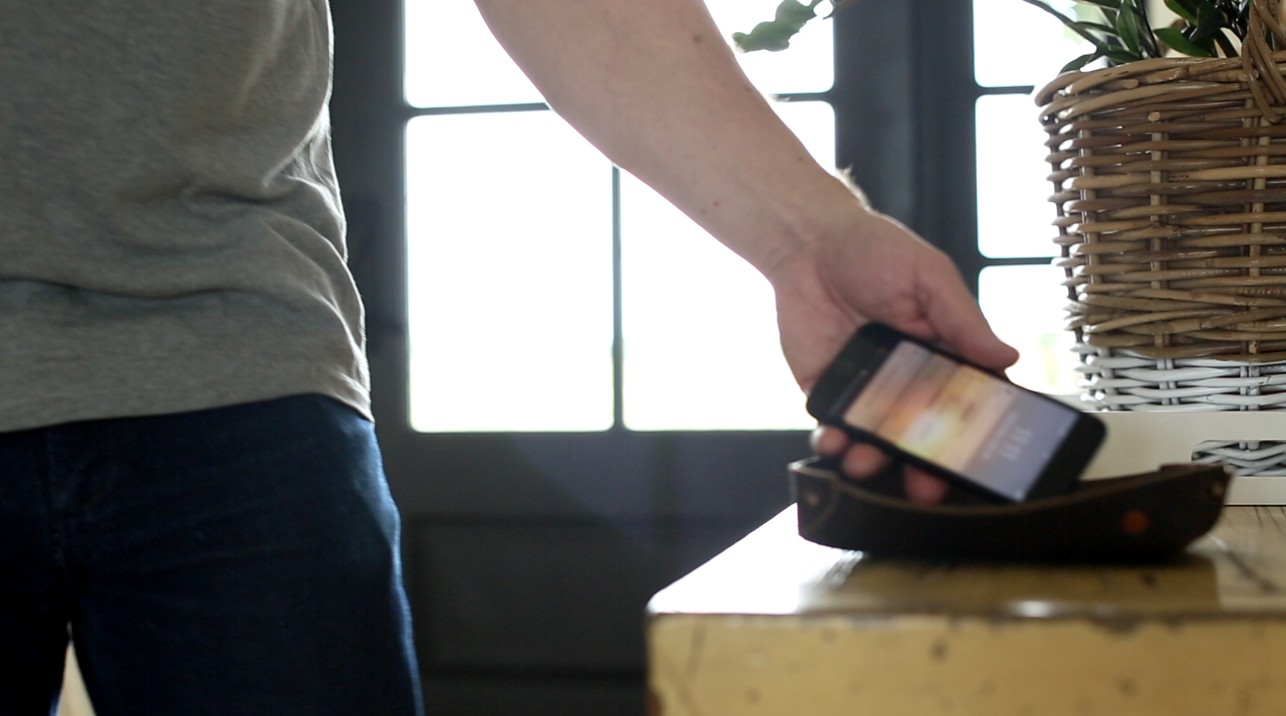 2. Put your phone down in one spot at home. Keeping your phone in one spot in your home has many benefits. It’s harder to lose it, and you’ll have a slight barrier to impulsive phone-checking: You’ll have to walk over and get it.
2. Put your phone down in one spot at home. Keeping your phone in one spot in your home has many benefits. It’s harder to lose it, and you’ll have a slight barrier to impulsive phone-checking: You’ll have to walk over and get it. 3. Don’t charge your phone by your bed. By keeping your phone out of the bedroom, you’ll prevent yourself from browsing right before bed, which can overstimulate your mind and make falling asleep difficult. In the morning, it will prevent you from checking it right away, and will help give your mind a chance to gradually wake up. If you’re feet haven’t even hit the floor, you shouldn’t already be surfing the web.
4. Grayscale Mode. If you have an iPhone, try grayscale mode. In the iPhone settings, under ‘accessibility,’ then ‘accessibility shortcut’, select ‘color filters.’ Now, when you triple-tap the home button on iPhones with a home button, or the side “lock” button on the newer notch iPhones, it will make the entire screen gray-scale. Triple-tap again to make it go back to full-color. You can set it to gray-scale during certain times you’d like to reduce phone use. This acts as a mental interrupt in the middle of your habitual behavior. It should be enough of a surprise to remind you that you’re checking your phone too much.
Breaking Apart the Swiss Army Knife
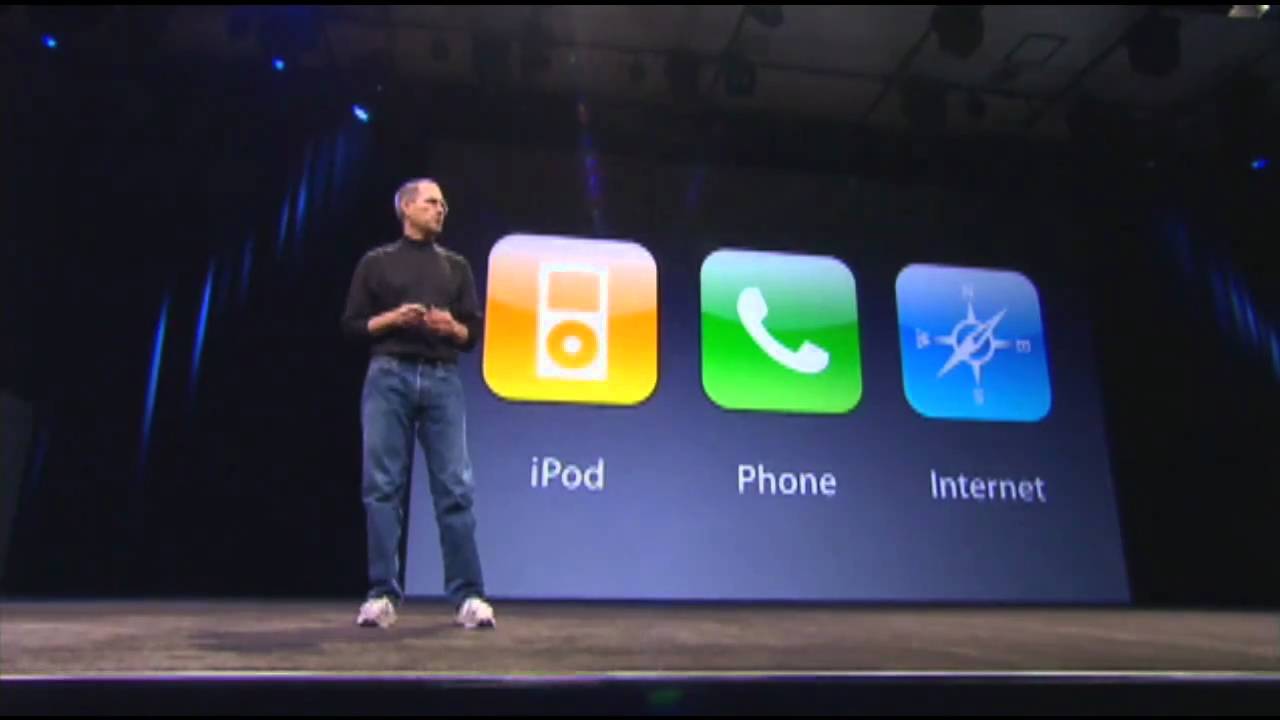 When Steve Jobs unveiled the iPhone, he announced that Apple was launching “a revolutionary new internet device, a revolutionary new touch-screen music player, and a revolutionary new phone.” Of course, all three of these were the iPhone, but his sales pitch highlights the “Swiss Army Knife” aspect of the device. It packs a lot of functionality into a pocket-sized computer, and if we’re being honest, most of the things it does can be done more effectively on a device dedicated to that specific task. But, the phone performs well enough, so that we accept the compromise, in exchange for the convenience.
When Steve Jobs unveiled the iPhone, he announced that Apple was launching “a revolutionary new internet device, a revolutionary new touch-screen music player, and a revolutionary new phone.” Of course, all three of these were the iPhone, but his sales pitch highlights the “Swiss Army Knife” aspect of the device. It packs a lot of functionality into a pocket-sized computer, and if we’re being honest, most of the things it does can be done more effectively on a device dedicated to that specific task. But, the phone performs well enough, so that we accept the compromise, in exchange for the convenience. I think the greatest “trick” of the smartphone is combining a phone line, which you feel you need on you at all times in case of an emergency, with all of the temptations the other apps offer. This is the biggest hook that our smartphones have in our mouths.
This year Maureen and I decided to try flip phones as our primary cell phones, while still keeping our smartphones as WiFi devices.
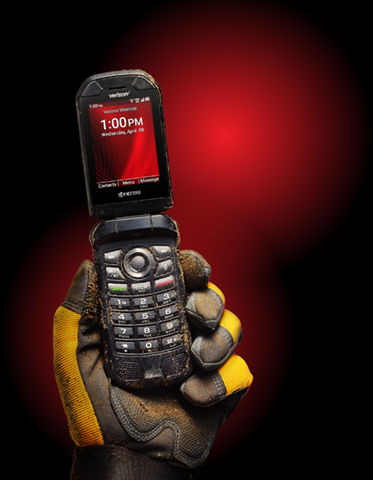 We went with unlocked Kyocera XV Extreme phones on eBay, which are actually pretty nice, modern flip phones. They’re durable, waterproof, and have a regular headphone jack, among other features. We also moved over to a new cell company called US Mobile, which is an MVNO, or Mobile Virtual Network Operator. MVNOs are a little bit slower on data speeds, but are much cheaper than the major carriers. If you’ve only ever used AT&T, Verizon or T-Mobile, it’s worth taking a look at the MVNOs. We’re only paying about $16 per line.
We went with unlocked Kyocera XV Extreme phones on eBay, which are actually pretty nice, modern flip phones. They’re durable, waterproof, and have a regular headphone jack, among other features. We also moved over to a new cell company called US Mobile, which is an MVNO, or Mobile Virtual Network Operator. MVNOs are a little bit slower on data speeds, but are much cheaper than the major carriers. If you’ve only ever used AT&T, Verizon or T-Mobile, it’s worth taking a look at the MVNOs. We’re only paying about $16 per line. We also purchased an unlocked Netgear Nighthawk cellular hotspot. This is a great little box that you set up just like a cell phone: You insert a SIM card, give it a data plan, and it broadcasts a WiFi network for devices to join. We keep it in our car, which allows us to use our smartphones when we’re out and about.
You might be thinking “But why add all of this needless complexity? You’re smartphone already does all of this! You’re just making your life complicated!”
 By separating out the emergency line with the flip phone, we are removing the excuse that we have to take our smart phones with us everywhere. It allows us to leave them in the car sometimes. Since the flip phone is the emergency line, we can keep that on us and know we’re reachable. And since we have the cellular hotspot in the car, we can keep our iPhones in there, and hop on WiFi if we need to do something online while away from home.
By separating out the emergency line with the flip phone, we are removing the excuse that we have to take our smart phones with us everywhere. It allows us to leave them in the car sometimes. Since the flip phone is the emergency line, we can keep that on us and know we’re reachable. And since we have the cellular hotspot in the car, we can keep our iPhones in there, and hop on WiFi if we need to do something online while away from home. If we go somewhere and want to take pictures, we just take the smartphones with us.We don’t have cell service though, so the temptation is removed to check it.
At home, I usually keep my smartphone on my desk in my office. It sits next to my desktop computer, which means if I need to do something online, I usually just do it on the computer, since it has a nice large screen, keyboard and mouse: A much nicer interface.
Texting
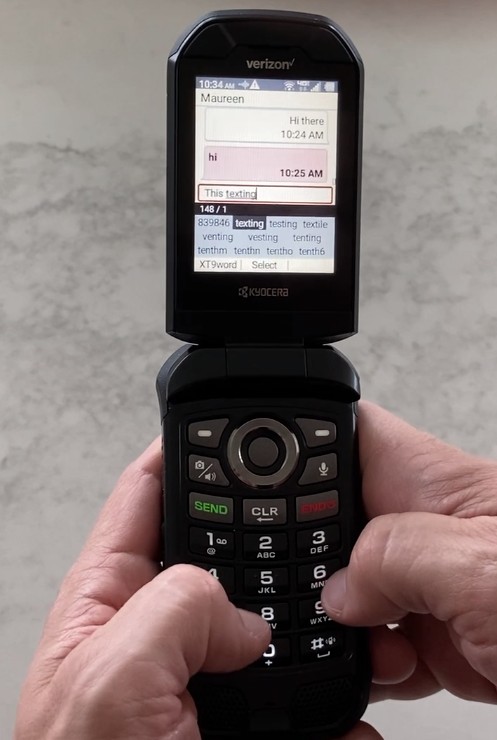 The biggest downside to the flip phone is texting on its number pad. What we’ve found ourselves doing is using dedicated texting apps on our smartphones such as Telegram, Apple Messages or Signal, and asking friends and family to message us through them. Most of these messaging apps also have desktop versions, so we’re able to use them both on the desktop and smartphone. We just have to remind people that we won’t be checking these text messages as often.
The biggest downside to the flip phone is texting on its number pad. What we’ve found ourselves doing is using dedicated texting apps on our smartphones such as Telegram, Apple Messages or Signal, and asking friends and family to message us through them. Most of these messaging apps also have desktop versions, so we’re able to use them both on the desktop and smartphone. We just have to remind people that we won’t be checking these text messages as often. The Gym
Taking the smartphone to the gym for music is really about the same. Most gyms have WiFi, and even if they don’t, you can usually download music to your smartphone in Spotify, Tidal, Apple Music or any of the other music apps.Changing Our Habits
With time and repetition, I’ve seen my own habits change. At first, not having my smartphone at a restaurant felt naked, and I’d get the impulse to check it. But that did recede after a while, and now I can feel that I’m not as anxious about not having that constant internet connection in my pocket.At home, we still have the smartphones available, but try to leave them in one spot in the house as mentioned above. This is enough of an interrupt to force us to stop and think if we really need to get our smartphones.
Absence
 Absence is topic we’ll probably expand on in future content. I think it’s the biggest benefit of breaking these addictive behaviors, and the easiest one to be overlooked.
Absence is topic we’ll probably expand on in future content. I think it’s the biggest benefit of breaking these addictive behaviors, and the easiest one to be overlooked. We fill vacant moments with mindless smartphone scrolling. And the sad thing is, we’ll never know what we lost in those moments. Absent time, alone with our thoughts, is when we come up with new ideas, new plans, new ways of thinking about something in our lives. It’s time when we build opinions, become creative, and our intentions take form. If we don’t give ourselves the time to build intention, we’ll never have it. If you’d like to dive into this topic, check out “The End of Absence: Reclaiming What We’ve Lost in a World of Constant Connection” [2] by Michael Harris.
There’s a belief that being constantly informed by our smartphones is going to make us smarter, or improve our lives. But not all of what we’re doing on our smartphones has value, and the information we do ingest may not be applicable to our lives. Instead of constantly checking our phones, we should set aside designated times to check them, and then put them aside.
I’d argue that smartphone use is causing an overall decline in our creativity. We’re just not spending enough time alone with our thoughts.
And absent time doesn’t have to be used only for creativity: It’s also a time for us to form opinions, think back over situations, think ahead to what we’ll be doing soon, and generally let our brain “digest” what it’s been thinking about. I think a lot of the anxiety we feel from our modern lives stems from a lack of ‘absence.’ We feel frantic because we’ve robbed minds of that valuable time to breathe.
What remains essential for the smartphone?
Should we still keep them around? I think so. Smartphones are still very useful devices when a regular computer isn’t available or convenient. It’s just that the smartphone has become too convenient, which has build very deep habits. Smartphones are good music players, and a touch screen interface works well for them. They’re also a perfect device for depositing checks with banking apps, since it combines a camera with an internet device. And most smartphones have very good cameras on them now, which makes them convenient for taking everyday photos.The Endgame
 This decoupling of the phone from the smartphone has provided many opportunities to reorganize our behaviors. We’re slowly ingraining better habits that help support better family time and better time utilization. We’re reducing stress and improving our attention spans.
This decoupling of the phone from the smartphone has provided many opportunities to reorganize our behaviors. We’re slowly ingraining better habits that help support better family time and better time utilization. We’re reducing stress and improving our attention spans. How do you know if the flip phone is right for you?
1. If you find yourself checking your phone during a movie that you paid to watch... you might want to try the flip phone.2. If you give a long monologue to a friend, and then when they start responding, you immediately pull your phone out to start scrolling… you might want to try the flip phone.
3. If you have small children and find them mimicking you looking at phones… you might want to try the flip phone.
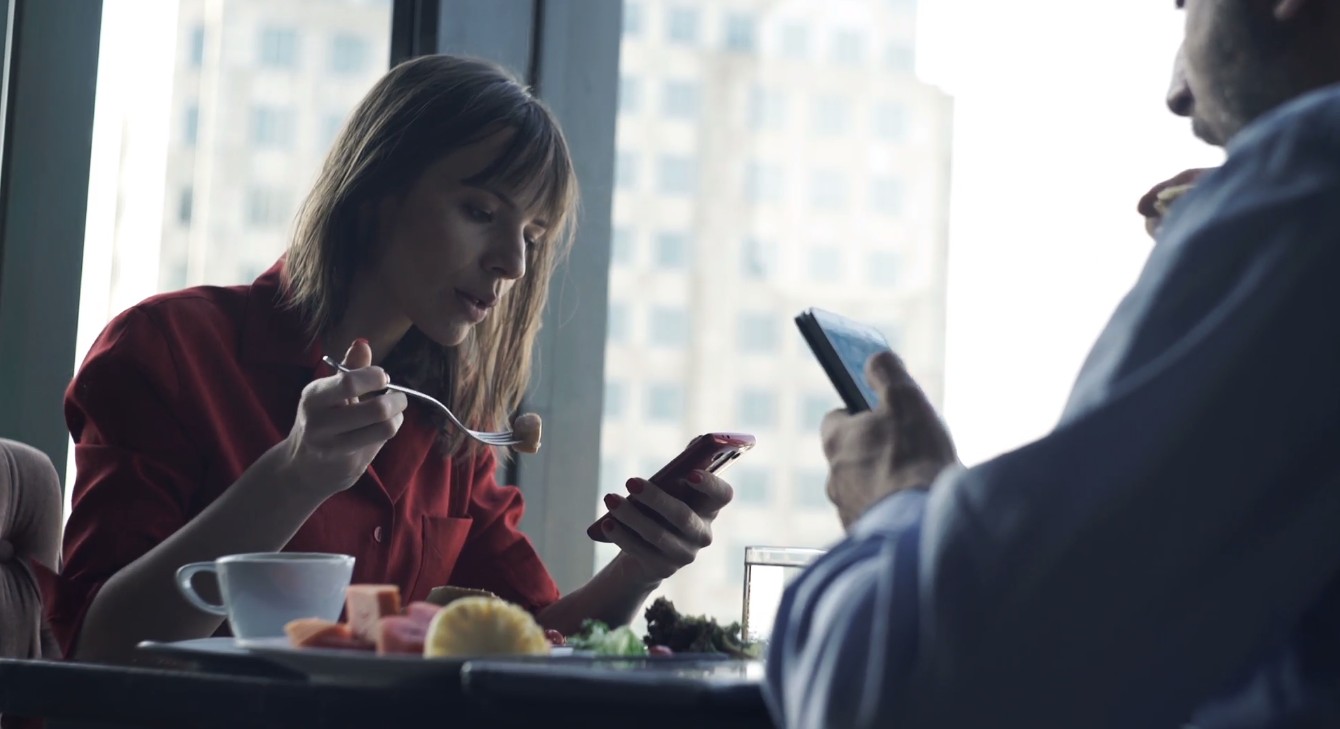 4. If you have a dinner with friends, yet still feel the need to check in with what’s happening on your phone… you might want to try the flip phone.
4. If you have a dinner with friends, yet still feel the need to check in with what’s happening on your phone… you might want to try the flip phone. 5. If you roll over and pick up your phone off your side table as soon as you wake up, or if it’s the last thing you look at before you go to bed… you might want to try the flip phone.
6. If you open your phone, check a series of apps, don’t find anything you like, and then immediately go back to the first one again to check if anything new is in it… you might want to try the flip phone.
Joys of the Flip Phone
Ending a call by closing a flip phone is extremely satisfying, and it doesn’t even have to be an angry hang-up to enjoy it. Having physical buttons for numbers (and navigation) is really nice. After using touch screens on phones for a decade, the tactile buttons feel solid and less prone to error. And now that almost everyone you see has a smartphone, having a flip phone definitely makes a statement. Most people who have seen mine have commented on how they preferred it, and wish they could go back to that. I always tell them they can—and hopefully this article provides some support on how to make that a reality.Notes:
1. BF Skinner: Schedules of Reinforcement2. The End of Absence by Michael Harris




